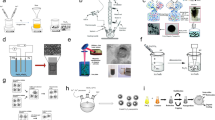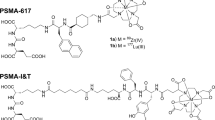Abstract
Purpose
Boron neutron capture therapy (BNCT) has the potential to become a viable cancer treatment modality, but its clinical translation requires sufficient tumor boron delivery while minimizing nonspecific accumulation.
Methods
Thermal sensitive liposomes (TSLs) were designed to have a stable drug payload at physiological temperatures but engineered to have high permeability under mild hyperthermia.
Results
We found that TSLs improved the tumor-specific delivery of boronophenylalanine (BPA) and boronated 2-nitroimidazole derivative B-381 in D54 glioma cells. Uniquely, the 2-nitroimidazole moiety extended the tumor retention of boron content compared to BPA.
Conclusion
This is the first study to show the delivery of boronated compounds using TSLs for BNCT, and these results will provide the basis of future clinical trials using TSLs for BNCT.


Similar content being viewed by others
References
Hawthorne MF, Lee M. A critical assessment of boron target compounds for boron neutron capture therapy. J Neuro-Oncol. 2003;62(1–2):33–45.
Hosmane NS. Boron and gadolinium neutron capture therapy for Cancer treatment. Singapore, SGP: World Scientific Publishing Co.; 2012.
Hosmane NS. Boron science : new technologies and applications. Boca Raton. FL: CRC Press; 2012.
Azab AK, Abu Ali H, Srebnik M. Chapter 5 Boron neutron capture therapy. In: Hijazi Abu Ali VMD, Morris S, editors. Studies in Inorganic Chemistry. Volume 22: Elsevier; 2006. p. 337–66.
Barth RF, Coderre JA, Vicente MGH, Blue TE. Boron neutron capture therapy of Cancer: current status and future prospects. Clin Cancer Res. 2005;11(11):3987–4002.
Luderer MJ, de la Puente P, Azab AK. Advancements in tumor targeting strategies for boron neutron capture therapy. Pharm Res. 2015;32(9):2824–36.
Heikkinen S, Savolainen S, Melkko P. In vitro studies on stability of L-p-boronophenylalanine–fructose complex (BPA-F). J Radiat Res. 2011;52(3):360–4.
Bergenheim AT, Capala J, Roslin M, Henriksson R. Distribution of BPA and metabolic assessment in glioblastoma patients during BNCT treatment: a microdialysis study. J Neuro-Oncol. 2005;71(3):287–93.
Liberman SJ, Dagrosa A, Jimenez Rebagliati RA, Bonomi MR, Roth BM, Turjanski L, et al. Biodistribution studies of boronophenylalanine-fructose in melanoma and brain tumor patients in Argentina. Applied radiation and isotopes : including data, instrumentation and methods for use in agriculture, industry and medicine 2004;61(5):1095–100.
Kankaanranta L, Seppala T, Koivunoro H, Valimaki P, Beule A, Collan J, et al. L-boronophenylalanine-mediated boron neutron capture therapy for malignant glioma progressing after external beam radiation therapy: a phase I study. Int J Radiat Oncol Biol Phys. 2011;80(2):369–76.
Pellettieri L, H-Stenstam B, Rezaei A, Giusti V, Sköld K. An investigation of boron neutron capture therapy for recurrent glioblastoma multiforme. Acta Neurol Scand. 2008;117(3):191–7.
Luderer MJ, Muz B, de la Puente P, Chavalmane S, Kapoor V, Marcelo R, et al. A hypoxia-targeted boron neutron capture therapy agent for the treatment of glioma. Pharm Res. 2016;33(10):2530–9.
Bernsen HJ, Rijken PF, Peters H, Raleigh JA, Jeuken JW, Wesseling P, et al. Hypoxia in a human intracerebral glioma model. J Neurosurg. 2000;93(3):449–54.
Olive PL, Durand RE, Raleigh JA, Luo C, Aquino-Parsons C. Comparison between the comet assay and pimonidazole binding for measuring tumour hypoxia. Br J Cancer. 2000;83(11):1525–31.
Kueffer PJ, Maitz CA, Khan AA, Schuster SA, Shlyakhtina NI, Jalisatgi SS, et al. Boron neutron capture therapy demonstrated in mice bearing EMT6 tumors following selective delivery of boron by rationally designed liposomes. Proc Natl Acad Sci. 2013;110(16):6512–7.
Frazier N, Ghandehari H. Hyperthermia approaches for enhanced delivery of nanomedicines to solid tumors. Biotechnol Bioeng. 2015;112(10):1967–83.
Staruch RM, Hynynen K, Chopra R. Hyperthermia-mediated doxorubicin release from thermosensitive liposomes using MR-HIFU: therapeutic effect in rabbit Vx2 tumours. International journal of hyperthermia : the official journal of European Society for Hyperthermic Oncology, North American Hyperthermia Group 2015;31(2):118–33.
Issels RD, Lindner LH, Verweij J, Wust P, Reichardt P, Schem B-C, Abdel-Rahman S, Daugaard S, Salat C, Wendtner CM, Vujaskovic Z, Wessalowski R, Jauch KW, Dürr HR, Ploner F, Baur-Melnyk A, Mansmann U, Hiddemann W, Blay JY, Hohenberger P, European Organisation for Research and Treatment of Cancer Soft Tissue and Bone Sarcoma Group (EORTC-STBSG)., European Society for Hyperthermic Oncology (ESHO). Neo-adjuvant chemotherapy alone or with regional hyperthermia for localised high-risk soft-tissue sarcoma: a randomised phase 3 multicentre study. The Lancet Oncology 2010;11(6):561–70.
Li L, ten Hagen TLM, Hossann M, Süss R, van Rhoon GC, Eggermont AMM, et al. Mild hyperthermia triggered doxorubicin release from optimized stealth thermosensitive liposomes improves intratumoral drug delivery and efficacy. J Control Release. 2013;168(2):142–50.
Kneidl B, Peller M, Winter G, Lindner LH, Hossann M. Thermosensitive liposomal drug delivery systems: state of the art review. Int J Nanomedicine. 2014;9:4387–98.
Makino K, Yamada T, Kimura M, Oka T, Ohshima H, Kondo T. Temperature-and ionic strength-induced conformational changes in the lipid head group region of liposomes as suggested by zeta potential data. Biophys Chem. 1991;41(2):175–83.
Szoka F Jr, Papahadjopoulos D. Comparative properties and methods of preparation of lipid vesicles (liposomes). Annu Rev Biophys Bioeng. 1980;9(1):467–508.
Grit M, Crommelin DJ. The effect of aging on the physical stability of liposome dispersions. Chem Phys Lipids. 1992;62(2):113–22.
Sauerwein W. Neutron capture therapy : principles and applications. Heidelberg ; New York: Springer; 2012. ix, 553 p. p.
ACKNOWLEDGMENTS AND DISCLOSURES
The material in this manuscript is original, has not been previously published and has not been submitted for publication elsewhere while under consideration. Dr. Azab receives research support from Glycomimetics Inc., Arch Oncology and Cantex Pharmaceuticals; and is the founder and owner of Targeted Therapeutics LLC and Cellatrix LLC; however, these have no contribution to this study. Other authors state no conflicts of interest.
Funding
The study was supported by the National Cancer Institute of the National Institutes of Health (NIH) Award (U54CA199092). Kinan Alhallak was supported by the National Center for Advancing Translational Sciences (NCATS) of the NIH Award (TL1TR002344). The content is solely the responsibility of the authors and does not necessarily represent the official view of the NIH.
Author information
Authors and Affiliations
Corresponding author
Additional information
Publisher’s Note
Springer Nature remains neutral with regard to jurisdictional claims in published maps and institutional affiliations.
Electronic supplementary material
ESM 1
(PDF 112 kb)
Rights and permissions
About this article
Cite this article
Luderer, M.J., Muz, B., Alhallak, K. et al. Thermal Sensitive Liposomes Improve Delivery of Boronated Agents for Boron Neutron Capture Therapy. Pharm Res 36, 144 (2019). https://doi.org/10.1007/s11095-019-2670-z
Received:
Accepted:
Published:
DOI: https://doi.org/10.1007/s11095-019-2670-z




